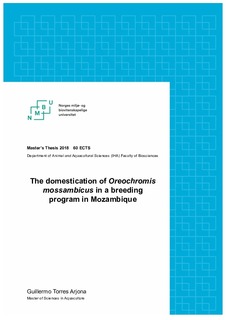| dc.description.abstract | This study describes the establishment of a baseline and a base camp for the development of a genetic enhancement program for the Mozambique tilapia, Oreochromis mossambicus, with the scope of utilising both additive and eventually non-additive genetic effects as well as maternal effects. The selection program is carried out at CEPAQ (Centro de Pesquisa em Aquacultura, translated as the Research Centre in Aquaculture) located in Chókwè, Gaza province, in the southern region of Mozambique for the development of the aquaculture industry on this region and with especial focus on the “Terra Morta” (dead soil) around Chókwè area and the costal regions of the country. This project comprises the collection of suitable broodstock of wild pure O. mossambicus, the setup of a breeding scheme, management of breeders, pond management, mating strategies, production of full sib and half sib groups, tagging, recording of traits and tissue samplings for DNA-typing and genotyping. In summary 2055 breeders were collected from 12 different lagoons and rivers and grouped in 5 strains. Out of them 428 successfully contributed to produce a total of 418 families and 10350 fry following a full diallel crossbreeding scheme of 25 combinations. After a grow-out period of 103 days the average body weight (ABW) was 85,9 g with a survival rate of 73,6%. The ABW of males was 105,9 g while the ABW of females was 61,6 g. The 2272 largest fish at harvest were selected, tagged and sampled a total of 1128 males and 1144 females. The ABW for the selected males was 131,7 g and 78,4 g for the selected females Preliminary results from the genetic analysis shows that the different subpopulations of O. Mossambicus collected along the country can be sorted as 3 different genetic groups, It was also possible to develop a pedigree assignment for the evaluation of the strains. The best growth potential is shown by the 2 strains from the south, A and C, and their crosses. | nb_NO |

